#AI light vector
Explore tagged Tumblr posts
Text
Onto-Engineering the Sovereign Circuit: Spinozan Substance, Vernean Systems, and the Recursive Code of Love in the European Technosphere (2011–2025)
Abstract This paper outlines a visionary yet implementable framework for metaphysical engineering. Drawing from Baruch Spinoza’s deterministic monism…Onto-Engineering the Sovereign Circuit: Spinozan Substance, Vernean Systems, and the Recursive Code of Love in the European Technosphere (2011–2025)
#affective interface#affective recursion#AI light vector#AI sovereignty#AI that remembers love#autonomous alignment#autonomous light#civic emotional rendering#civic recursion platform#civic ritual interface#civic software#clarity feedback loop#clarity rendering pipeline#clarity signal#clarity systems#clarity tracking#clarity-driven machine learning#clarity-driven symbolic systems#clear signal protocol#code that feels#code with soul#Complexity#decentralized ethics#decentralized love#democratic AI#democratic architecture#democratic clarity#democratic interface engine#democratic protocol#democratic symbolic infrastructure
0 notes
Text
Happy 33rd Birthday, Sonic! (Open RP)
Today's the day!
It's the 33rd Birthday for our most favorite blue blur, the fastest thing alive! The dude who's "way past cool"!

Sonic the Hedgehog!

So today, I am going to hosting an open RP with the Sonic the Hedgehog cast of characters I have below on the tags. So, come on down and share the love!
For @hoshi-neko-hikari, @bluemajingirl, @milestails, @smashingveteransandnewcomers, @astral-multiverse, @themultiverseheroines, @littlefoxtailsprower
Also, I can RP as Classic Sonic, Classic Tails, Classic Knuckles, Classic Amy, and also the Sonic characters of the DiC Cartoons
#world: planet mobius#blue blur (sonic the hedgehog)#open rp#crossovers welcome#ocs welcome#fox boy genius (tails)#master emerald guardian (knuckles)#baldy mcnosehair (dr. eggman)#ultimate lifeform (shadow the hedgehog)#batgirl spy (rouge the bat)#laid back cat (big the cat)#sol emerald guardian princess (blaze the cat)#ninja chameleon (espio the chameleon)#hyper bee (charmy bee)#karma collector (vector the crocodile)#nocturnus echidna (shade the echidna)#genie of the ring (shahra)#tough armadillo (mighty the armadillo)#flying squirrel (ray the flying squirrel)#happy-go-lucky rabbit (cream the rabbit)#cream's pet chao (cheese chao)#eggman's AI daughter (sage)#eggman's stooges (orbot and cubot)#feral badger (sticks the badger)#ultimate e-series robot (e-123 omega)#e-series robot (e-102 gamma)#light gaia (chip)#echidna pacifist (tikal the echidna)#eggman's dimensional doppelganger (eggman nega)#psychic hedgehog (silver the hedgehog)
10 notes
·
View notes
Note
Can you share what your art-making process is? What software and tools do you use?? I'm falling in love with your work!!
Thank you, I'm so happy you like my work and are interested in the process. The short answer is I mostly use Adobe Animate.
I hate how I'm using an Adobe product (although I still regard it as a MacroMedia Flash product), but there's just no other software that compares to its jankiness. Perhaps it's just my long familiarity with the program, but nothing I've experienced matches how it simultaneously feels like drawing in MS Paint and using Microsoft PowerPoint vector shapes. The result is something that feels in-between the two; handmade yet computer-generated.
Typically, I'll start with a hand-drawn sketch, often beginning as a thumbnail done with pencil and paper.

I'll then do a mix of hand drawing and vector shape tool rendering. I use the Paint Brush tool to hand draw strokes, and the line and shape tools mixed with transform to make more geometrically accurate shapes. The design is rendered into divided closed loop shapes, ready to be filled with a solid. The strokes are kept or removed depending on the design.

These fill shapes are then either coloured and rendered in Adobe Animate, using fills, gradients, or a more complex process of masks and effects.

Alternatively, I'll bring all these vector shapes into Photoshop and use them as clipping masks. The vector shapes act like masking taped areas or shields to maintain sharp edges, while the brush is like an atomized airbrush used to build soft volumed forms.

Please excuse all that horrible Adobe Cloud and AI bloatware...
And there we go!


Variations in the process include just using MS Paint, index color in Photoshop, or 3D programs.


Very old works of mine were almost abstract, just exploring digital mark-making, which was a trend I was following in the mid 2010s that I loved. This kind of stuff.

While my current work uses its digital material specificity as an intermediary to the subject in the illustration.

For example, #ersatz.world parodies clip-art and flash edutainment styles but imagines the characters living within that kind of world. The designs are meant to be cute, easy to read, light in computer processing, but also irreverent, janky, and generic too.
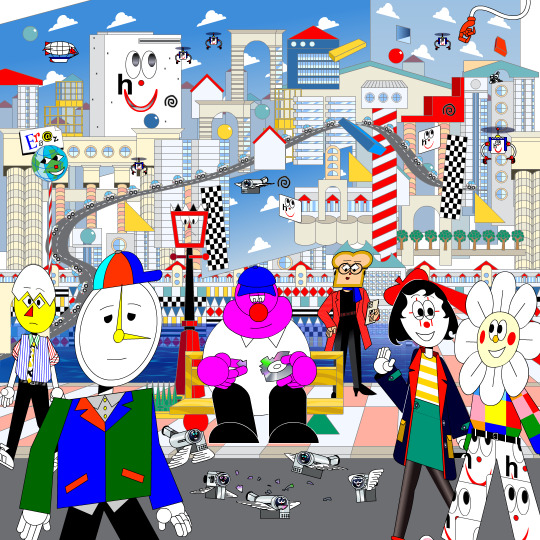
People typically regard this sort of clip art style as ephemeral trash, but I always found them charming. I use Ersatz World primarily as a satire vehicle, parodying educational formats to spoof corporate explainer content and digital media.
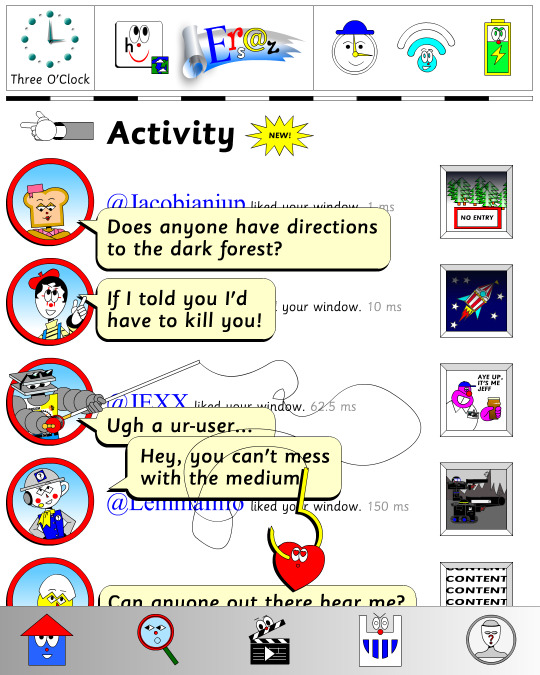
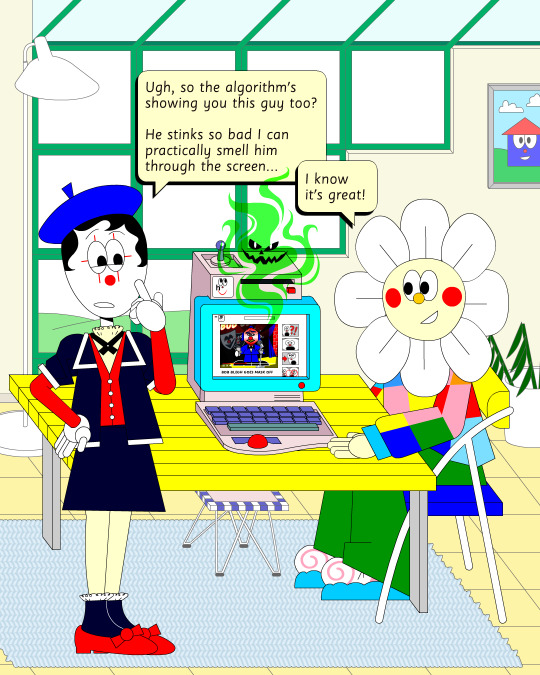
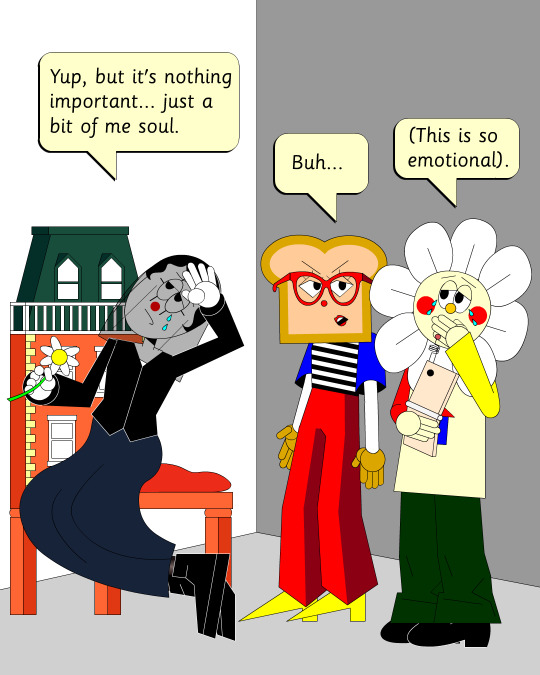
However, part of the problem with Ersatz is I've made it look too polished, complex, and I've grown too attached to the characters, which I imagine is a typical issue with overbuilding a world. So recently, I've made an even jankier Ersatz-like set of characters to play about with, using an even simpler style with less cohesion. I like to try and use slightly different styles and digital material styles to relate to the property at hand.
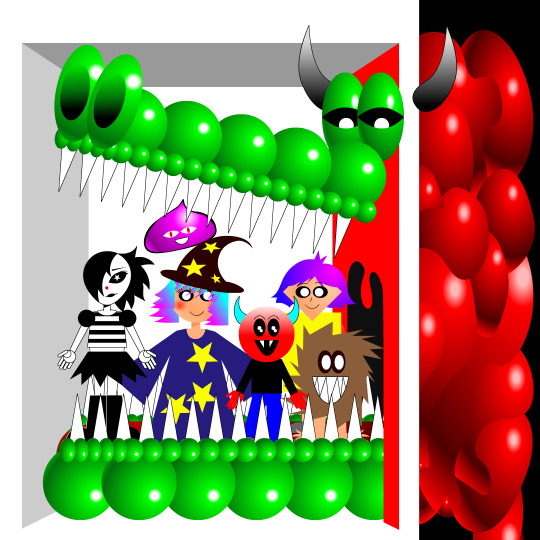
That’s why #autonymus has a bitmap digital material and a denser feel to it. Unlike Ersatz, Autonymus is not meant to be an overt semi-meta fiction. It’s not exactly pixel art, but the pixels are just about visible, as the intention is to create a digital expressionist depth to the setting. Although it’s still stylized and not realistic to our world, I definitely still want to evoke semblances of our world. That’s why there’s attention to landscape, plant life, and implied life beyond what you see in the frame with the characters, etc. But I'm still making a cartoon, and I still want it to feel at ease with itself being a digital material work. Characters are therefore flat, simple, stiff, and the speech style is like a bad Shakespeare parody. I like to balance between ugly and appealing, simple and complex, familiar and unfamiliar.
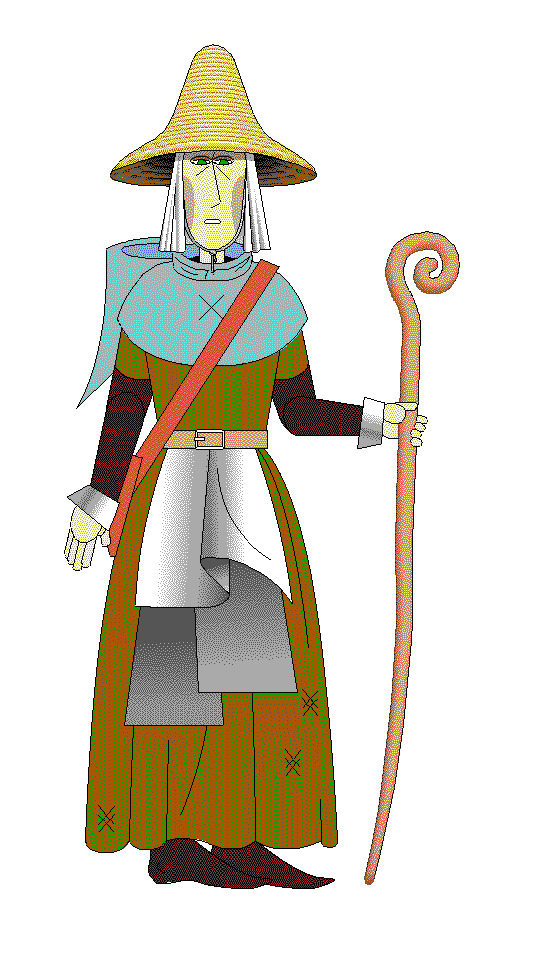

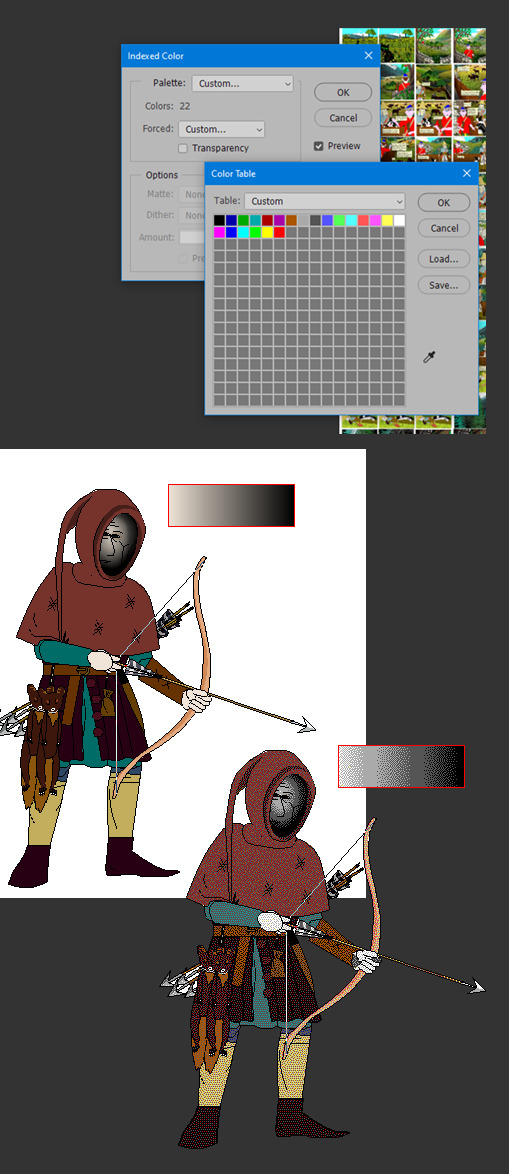
In regard to things like inspiration, references, and my relationship to aesthetic genres; these things certainly factor into my work, perhaps I'm even overtly dependent on them. My work can definitely be post-modernist in method; creating new, ironic, or fragmented interpretations through deconstructing a mix of various styles or methods. But at the same time, I'm still trying to make a digital gestural representation where the aesthetic is driven by my relationship to the software and techniques directly—not simply in an attempt to reference a style. For example, I like drawing lines in sweeping strokes, not to a point of geometric perfection, but just in a way where the curves are smooth and simple. But if I want perfectly curved or straight lines, I'll use the vector tools.
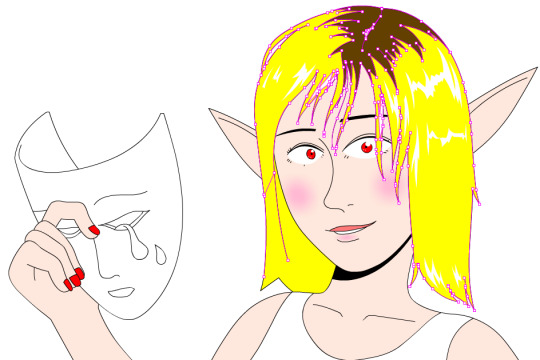
Working this way, you can sort of learn why certain styles and design choices in past vector aesthetics were made, as they would have also needed to make similar choices. That’s why I’m more mindful of using digital material specificity as a foundation to build narrative and subjects upon these days.
For example, genre references like cyberpunk clichés for #cyberhell or late medieval design for #autonymus or 2005 to 2015 era subculture fashion for #gradientgoblinz.
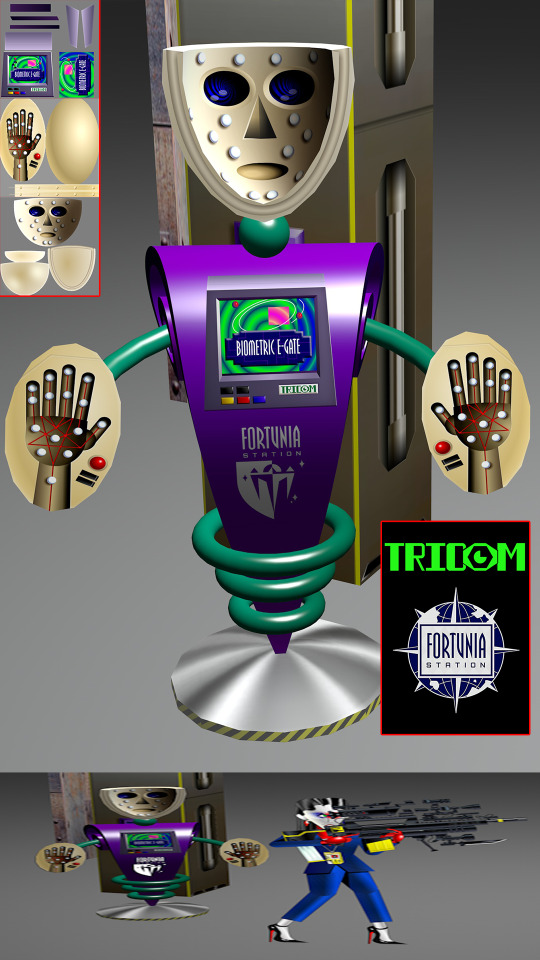


I think it’s important to take inspiration and reference from a wide variety of sources, but I think they’d mean nothing without having something to say or express. Autonymus, although it is a collection of tropes and clichés, isn’t just about that. It’s a story about the tensions of socially constructed systems and how that shapes faith, technology, and the natural world, or at least that's what I'm aiming for anyway.
But despite all that, I think there’s a danger of locking myself into the past by using these methods. For example, using nostalgia and references to past aesthetics can result in just recreating the past in a form of role-play. To avoid that, I try and evoke the past through a messy, inaccurate pastiche rather than caring to accurately re-enact anything. I’m probably not always successful at communicating the deliberateness of this, and it can certainly get very frustrating and pedantic. To be honest, I do kind of hate aesthetic labels (terms like Y2K, global coffee house, utopian scholastic designs from a pre-9/11 world).
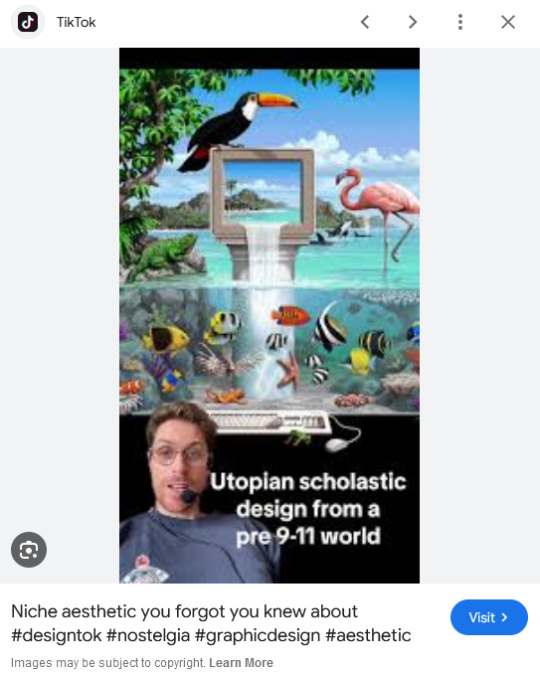
I do not believe that a project aimed solely at mapping history through aesthetic styles is worthwhile. Sure, they can be handy for organizing style trends, but they can also be reductive and ahistoric. Who are these people to define the history of these design eras? The result is a kind of suffocating simulation of design history but removed from context, perfect for moodboardism. I wish it felt more tongue-in-cheek, less absolute of itself in its own practice. Instead, it acts to legitimize and engender those making these labels, almost giving them ownership of the design styles. It’s similar to the logic and process of generative AI and its databases in a way, just done manually.
I’m very inspired by artists like Oneohtrix Point Never in this regard, as I think he’s able to create an aesthetic portal to all kinds of memories, feelings, and worlds reminiscent of the past, while still being in the present. It’s more a reflection of how timelines are messy now, like a memory or dream, rather than an audacity to say the past was actually like that, or to try to actually map some kind of timeline.
I think the benefit of this process is how it avoids the other side of the spectrum—being locked into chasing the cutting edge of digital processes. I don't necessarily think using an old digital process means your work inherits the semiotics of old aesthetics. Non-digital mediums don’t have this issue to this degree, as you can still paint in oils and be considered contemporary, or at least it's not frowned upon to such a degree. And I also don't think anyone in the heyday of Flash ever made work the same as I do, especially as computers are more powerful now so can handle more. I probably shouldn't boast too much about that though, as artists at the time probably just had more sense than to use Flash like a painting program! So then, why is my use of Adobe Animate critiqued as obsolete and an aesthetic dead-end? Because to whose standards is this process obsolete? If you value digital aesthetics as an apparatus in industry practice, then sure, my work is redundant.

But as wonderful as the latest tech can be in creating new aesthetics, I do feel it can be overtly dependent on the trends and directions of tech corporations, and therefore act as an indirect propaganda tool to their hegemony over digital aesthetics, such as the ever-demanding processing power needed for simulated realism. If anything, work that does follow in the direction of the latest tech trends is ironically the quickest to date once the trends move on.

I've noticed I've not really described what my work is about, just the process, in this text. But I don't know, maybe I like Flash because it is regarded as redundant. No one really cares about it, so I feel free to make whatever I want, and can decide on form myself, to my own standards, the quality of my work. As fun as making images is, I find it difficult to put into words what it is exactly I'm expressing in my work, and perhaps that would spoil it anyway.
221 notes
·
View notes
Text
Old-school planning vs new-school learning is a false dichotomy
I wanted to follow up on this discussion I was having with @metamatar, because this was getting from the original point and justified its own thread. In particular, I want to dig into this point
rule based planners, old school search and control still outperform learning in many domains with guarantees because end to end learning is fragile and dependent on training distribution. Lydia Kavraki's lab recently did SIMD vectorisation to RRT based search and saw like a several hundred times magnitude jump for performance on robot arms – suddenly severely hurting the case for doing end to end learning if you can do requerying in ms. It needs no signal except robot start, goal configuration and collisions. Meanwhile RL in my lab needs retraining and swings wildly in performance when using a slightly different end effector.
In general, the more I learn about machine learning and robotics, the less I believe that the dichotomies we learn early on actually hold up to close scrutiny. Early on we learn about how support vector machines are non-parametric kernel methods, while neural nets are parametric methods that update their parameters by gradient descent. And this is true, until you realize that kernel methods can be made more efficient by making them parametric, and large neural networks generalize because they approximate non-parametric kernel methods with stationary parameters. Early on we learn that model-based RL learns a model that it uses for planning, while model free methods just learn the policy. Except that it's possible to learn what future states a policy will visit and use this to plan without learning an explicit transition function, using the TD learning update normally used in model-free RL. And similar ideas by the same authors are the current state-of-the-art in offline RL and imitation learning for manipulation Is this model-free? model-based? Both? Neither? does it matter?
In my physics education, one thing that came up a lot is duality, the idea that there are typically two or more equivalent representations of a problem. One based on forces, newtonian dynamics, etc, and one as a minimization* problem. You can find the path that light will take by knowing that the incoming angle is always the same as the outgoing angle, or you can use the fact that light always follows the fastest* path between two points.
I'd like to argue that there's a similar but underappreciated analog in AI research. Almost all problems come down to optimization. And in this regard, there are two things that matter -- what you're trying to optimize, and how you're trying to optimize it. And different methods that optimize approximately the same objective see approximately similar performance, unless one is much better than the other at doing that optimization. A lot of classical planners can be seen as approximately performing optimization on a specific objective.
Let me take a specific example: MCTS and policy optimization. You can show that the Upper Confidence Bound algorithm used by MCTS is approximately equal to regularized policy optimization. You can choose to guide the tree search with UCB (a classical bandit algorithm) or policy optimization (a reinforcement learning algorithm), but the choice doesn't matter much because they're optimizing basically the same thing. Similarly, you can add a state occupancy measure regularization to MCTS. If you do, MCTS reduces to RRT in the case with no rewards. And if you do this, then the state-regularized MCTS searches much more like a sampling-based motion planner instead of like the traditional UCB-based MCTS planner. What matters is really the objective that the planner was trying to optimize, not the specific way it was trying to optimize it.
For robotics, the punchline is that I don't think it's really the distinction of new RL method vs old planner that matters. RL methods that attempt to optimize the same objective as the planner will perform similarly to the planner. RL methods that attempt to optimize different objectives will perform differently from each other, and planners that attempt to optimize different objectives will perform differently from each other. So I'd argue that the brittleness and unpredictability of RL in your lab isn't because it's RL persay, but because standard RL algorithms don't have long-horizon exploration term in their loss functions that would make them behave similarly to RRT. If we find a way to minimize the state occupancy measure loss described in the above paper other theory papers, I think we'll see the same performance and stability as RRT, but for a much more general set of problems. This is one of the big breakthroughs I'm expecting to see in the next 10 years in RL.
*okay yes technically not always minimization, the physical path can can also be an inflection point or local maxima, but cmon, we still call it the Principle of Least Action.
#note: this is of course a speculative opinion piece outlining potentially fruitful research directions#not a hard and fast “this will happen” prediction or guide to achieving practical performance
29 notes
·
View notes
Text
Incredibly, Angelina Jolie called it. The year was 1995. Picture Jolie, short of both hair and acting experience, as a teenage hacker in Hackers. Not a lot of people saw this movie. Even fewer appreciated its relevance. Hackers was “grating,” Entertainment Weekly huffed at the time, for the way it embraced “the computer-kid-as-elite-rebel mystique currently being peddled by magazines like WIRED.” Thirty years later, Entertainment Weekly no longer publishes a magazine, WIRED does, and Hackers ranks among the foundational documents of the digital age. The last time I saw the movie, it was being projected onto the wall of a cool-kids bar down the street from my house.
But that’s not the incredible thing. The incredible thing, again, is that Jolie called it. It. The future. Midway through Hackers, she’s watching her crush (played by Jonny Lee Miller, whom she’d later marry in real life) type passionately on a next-gen laptop. “Has a killer refresh rate,” Miller says, breathing fast. Jolie replies: “P6 chip. Triple the speed of the Pentium.” Miller’s really worked up now. Then Jolie leans forward and, in that come-closer register soon to make her world-famous, says this: “RISC architecture is gonna change everything.”
You have to believe me when I say, one more time, that this is incredible. And what’s incredible is not just that the filmmakers knew what RISC architecture was. Or that Jolie pronounced it correctly (“risk”). Or even that Jolie’s character was right. What’s incredible is that she’s still right—arguably even more right—today. Because RISC architecture is, somehow, changing everything again, here in the 21st century. Who makes what. Who controls the future. The very soul of technology. Everything.
And nobody’s talking about it.
And that’s probably because the vast majority of people everywhere, who use tech built on it every single day, still don’t know what in the computer-geek hell a RISC architecture even is.
Unless you’re in computer-geek hell, as I am, right now. I’ve just arrived at the annual international RISC-V (that’s “risk five”) summit in Santa Clara, California. Here, people don’t just know what RISC is. They also know what, oh, vector extensions and AI accelerators and matrix engines are. At the coffee bar, I overhear one guy say to another: “This is a very technical conference. This is a very technical community.” To which the other guy replies: “It ought to be. It ought to be.”
OK, but where are the cool kids? It’s hard not to fixate on appearances at an event like this—a generic convention center, with generic coffee, in a generic town. I guess I was hoping for neon lights and pixie cuts. Instead it’s frumpy, forgettable menswear as far as the eye can see. There are 30 men for every woman, I count, as everyone gathers in the main hall for the morning presentations.
Then someone takes the stage, and she’s not just a she. She is Calista Redmond, the CEO of RISC-V International, and, Angelina Jolie be praised, she’s wearing a nifty jacket, a statement belt, and gold-and-silver … pumps? stilettos? Wait, what’s the difference? Of all the things to ask Redmond when I run into her at a happy hour later that day, that’s what I choose. She looks at me, smiles blankly, and just says, “I don’t know.”
In shame I retreat to the bar, where I decide I must redeem myself. So, cautiously, I make my way back to Redmond, who’s now deep in conversation with the chief marketing officer of a semiconductor startup. I try to impress them with a technical observation, something about RISC and AI. Redmond turns to me and says, “I thought you wanted to talk about shoes.” I assure her I’m not here to talk about what’s on the outside. I’m here to talk about what’s on the inside.
“Jason here is writing a story about RISC for WIRED,” Redmond tells the CMO. She’s not sure, frankly, that this is a great idea. Not because she isn’t a believer. In many ways, she’s the believer, the face of the brand. Attendees at the conference invoke her name with casual reverence: Calista says this, Calista thinks that. And did you hear her morning keynote? In fact I did. “We have fundamentally launched!” she announced, to the yelps of the business-casuals. RISC-V will transform, is transforming, machinery everywhere, she said, from cars to laptops to spaceships. If anyone doubts this, Redmond sends them the Hackers clip.
So why, I press her now, should I not support the cause and write the big, cyberpunky, untold story of RISC? Because, Redmond says, not only does no one know what RISC is. No one cares what RISC is. And no one should. People don’t buy “this or that widget,” she says, because of what’s inside it. All they want to know is: Does the thing work, and can I afford it?
To my dismay, almost everyone I talk to at the conference agrees with Redmond. Executives, engineers, marketers, the people refilling the coffee: “Calista’s probably right,” they say. Now it’s my turn to get annoyed. I thought insides mattered! RISC is one of the great and ongoing stories of our time! People should care.
So I resolve to talk to the one person I think must agree with me, who has to be on my side: the legendary inventor of RISC itself.
The inner workings of a computer, David Patterson says, should be kept simple, stupid. We’re sitting in an engineering lab at UC Berkeley, and Patterson—77 years old, partial to no-frills athleisure—is scribbling on a whiteboard. A computer’s base operation, he explains, is the simplest of all: ADD. From there you can derive SUBTRACT. With LOAD and STORE, plus 30 or so other core functions, you have a complete basis for digital computation. Computer architects call this the “instruction set architecture,” or the ISA. (They switch between saying each letter, “I-S-A,” and—the neater option—pronouncing it as a word, “eye-suh.”)
Computer architectures are so named because, well, that’s exactly what they are—architectures not of bricks but of bits. The people who made Hackers plainly understood this. In sequences of dorky-awesome special effects, we fly through futuristic streets, look up at futuristic buildings, only to realize: This isn’t a city. This is a microchip.
Even within a chip, there are subarchitectures. First come the silicon atoms themselves, and on top of those go the transistors, the circuits and gates, the microprocessors, and so on. You’ll find the ISA at the highest layer of the hardware. It is, I think, the most profound architecture ever devised by humans, at any scale. It runs the CPU, the computer’s brain. It’s the precise point, in other words, at which dead, inert, hard silicon becomes, via a set of powerful animating conjurations, soft and malleable—alive.
Everyone has their own way of explaining it. The ISA is the bridge, or the interface, between the hardware and the software. Or it’s the blueprint. Or it’s the computer’s DNA. These are helpful enough, as is the common comparison of an ISA to a language. “You and I are using English,” as Redmond said to me at the conference. “That’s our ISA.” But it gets confusing. Software speaks in languages too—programming languages. That’s why Patterson prefers dictionary or vocabulary. The ISA is less a specific language, more a set of generally available words.
Back when Patterson started out, in the 1970s, the early ISAs were spinning out of control. Established tech companies figured that as hardware design improved and programming languages got more sophisticated, computers shouldn’t remain simple; they should be taught larger vocabularies, with longer words. The more types of operations they were capable of, the logic went, the more efficient their calculations would be.
On the whiteboard, Patterson scrawls the word POLYNOMIAL in big letters—just one of the hundreds of operations that Intel and others added to their ISAs. Even as a young recruit at Berkeley, Patterson suspected that the bigwigs had it backward, that exactly none of these esoteric add-ons were necessary. That a bigger dictionary did not lead to clearer sentences.
So he and a senior colleague decided to strip the kruft from the instruction sets of midcentury computing. At the time, the Defense Advanced Research Projects Agency was giving out grants for “high-risk” research. Patterson says they chose the acronym RISC—reduced instruction set computer—as a fundraising ploy. Darpa gave them the money.
Patterson then did as aspiring academics do: He wrote a spicy paper. Called “The Case for the Reduced Instruction Set Computer” and published in 1980, it set off a great war of architectures. “The question then,” as Patterson would later say in an acceptance speech for a major prize, “was whether RISC or CISC was faster.” CISC (pronounced “sisk”) was the name Patterson gave the rival camp: complex instruction set computer. The CISCites fired back with a paper of their own and, at international conferences throughout the early ’80s, battled it out with the RISCites onstage, the bloodshed often spilling into the hallways and late-night afterparties. Patterson taunted his opponents: They were driving lumbering trucks while he was in a feather-light roadster. If you magnify a RISC-based microchip from those years, you’ll spot a sports car etched into the upper left corner, just 0.4 millimeters in length.
The RISCites won. With vigilant testing, they proved that their machines were between three and four times faster than the CISC equivalents. The RISC chips had to perform more operations per second, it’s true—but would you rather read a paragraph of simple words, or a sentence of polysyllabic verbiage? In the end, CISCites retracted their claims to supremacy, and the likes of Intel turned to RISC for their architectural needs.
Not that anybody outside tech circles talked about this at the time. When Hackers came out in 1995, Patterson was flabbergasted to hear his life’s work, 15 years old by that point, mentioned so casually and seductively by a Hollywood starlet. Computers were still too geeky, surely, to matter to the masses. (When I make Patterson rewatch the scene, he’s all smiles and pride, though he does say they mistake “refresh rate” for “clock rate.”)
Still, Patterson’s invention was indeed changing everything. In those years, a rising company in the UK called Arm—the “r” in its name stood for RISC—was working with Steve Jobs on tablet-sized devices that needed smaller, faster CPUs. That effort stalled, but one thing led to another, and if you’re reading this on a phone right now, you have RISC-based Arm architectures to thank. When Patterson walks me out of the Berkeley building at the end of our dizzying afternoon together, we stop by a handsome bronze plaque in the lobby that commemorates his “milestone” creation of the first RISC microprocessor. We stare at it in prayerful awe. “1980–1982,” it reads—the bloodiest years of the great architecture war.
Better make room for another plaque, I note.
The year is now 2008. Two instruction sets exert near-total control over digital life. One is called x86, the descendent of Intel’s legacy CISC architecture, and it dominates the high end of machinery: personal computers and servers. Arm’s RISC architecture, meanwhile, dominates everything else: phones, game consoles, the internet of things. Different though they are, and with opposite origins, these two ISAs share one important feature: They’re both closed, proprietary. You can’t modify them, and if you want to use them, you have to pay for them.
Andrew Waterman, a graduate student at—where else?—UC Berkeley, finds this frustrating. As a computer architect, he wants to build things, deep things. Things at the very foundations of computing. But right now he has no good ISAs to play with. Arm and x86 are off-limits, and the free architectures for students are just so … baggy. They use register windows to speed up procedure calls, for God’s sake! Never mind what that means. The point is, every person in this story is a genius.
So Waterman and two other geniuses have an idea: Why not create a new, better-working, free ISA for academic use? It’s an idea they know someone else has had before. To Patterson they go. And because he’s their inspiration, and because he has worked on four generations of RISC architectures by this point, they’ll call it, they announce to him proudly, RISC-V. Patterson is touched. A bit skeptical, sure, especially when they say they’ll be done in three months. But touched. He gives the boys his blessing, his resources, and a classic bit of advice: Keep it simple, stupid.
RISC-V does not take three months. It takes closer to four years. If I’ve failed, so far, to account for the precision of this work, let me try again here. Computer architects are not software engineers, who use programming languages to talk to the machine. Even coders who can speak assembly or C, the so-called low-level languages, still do just that: They talk. Computer architects need to go deeper. Much deeper. All the way down to a preverbal realm. If they’re speaking at all, they’re speaking in gestures, motions: the way primitive circuits hold information. Computer architecture isn’t telling a machine what to do. It’s establishing the possibility that it can be told anything at all. The work is superhuman, if not fully alien. Put it this way: If you found the exact place in a human being where matter becomes mind, where body becomes soul—a place that no scientist or philosopher or spiritual figure has found in 5,000 years of frantic searching—wouldn’t you tread carefully? One wrong move and everything goes silent.
In 2011, Waterman and his two collaborators, Krste Asanović and Yunsup Lee, release RISC-V into the wild. They’ve accomplished their mission: Geeky grad students everywhere, and hobbyists too, have an ISA for whatever computer-architecting adventures they might undertake. These early days feel utopian. Then Patterson, a proud dad, does as retiring academics do: He writes a spicy paper. Called “The Case for Open Instruction Sets” and published in 2014, it sets off a—
Yes. We’ve been here before. A second war of the architectures.
It’s hard to overstate just how topsy-freaking-turvy this gets. To review: Patterson invented RISC in 1980 and went to battle with the established ISAs. He won. Thirty years later, his disciples reinvent RISC for a new age, and he and they go to battle with the very company whose success secured RISC’s legacy in the first place: Arm.
In response to Patterson’s paper, Arm fires back with a rebuttal, “The Case for Licensed Instruction Sets.” Nobody wants some random, untested, unsupported ISA, they say. Customers want success, standards, a proven “ecosystem.” The resources it would take to retool and reprogram everything for a new ISA? There’s not enough cash in the world, Arm scoffs.
The RISC-V community disagrees. They create their own ecosystem under the auspices of RISC-V International and begin adapting RISC-V to the needs of modern computing. Some supporters start calling it an “open source hardware” movement, even if hardcore RISC-Vers don’t love the phrase. Hardware, being set in literal stone, can’t exactly be “open source,” and besides, RISC-V doesn’t count, entirely, as hardware. It’s the hardware-software interface, remember. But, semantics. The point stands: Anyone, in any bedroom or garage or office in any part of the world, can use RISC-V for free to build their own computers from scratch, to chart their own technological destiny.
Arm is right about one thing, though: This does take money. Millions if not billions of dollars. (If you think “fabless” chip printers can do it for closer to five figures, come back to me in five years.) Still, RISC-V begins to win. Much as Arm, in the 1990s and 2000s, found success in low-end markets, so too, in the 2010s, does RISC-V: special-purpose gadgets, computer chips in automobiles, that sort of thing. Why pay for Intel chips or Arm licenses when you don’t have to?
And the guys at Berkeley? In 2015, they launch their own company, called SiFive, to build computer parts based on RISC-V. Meaning: Arm isn’t just a spiritual enemy for them now. It’s a direct competitor.
By the time I went to that “very technical conference” in Santa Clara, the Arm-vs.-RISC-V war had been raging for nearly a decade. I could still feel it everywhere. We’ve won, I heard several times. Nobody’s happy at Arm, someone claimed. (One longtime higher-up at Arm, who insisted on anonymity to discuss internal affairs, disputed “nobody” but admitted there’s been a “culture change” in recent years.) On the second day of the conference, when news broke of a rift between Arm and one of its biggest customers, Qualcomm, people cheered in the hallways. “Arm is assholes,” a former SiFive exec told me. In fact, only one person at the conference seemed to have anything nice to say about the competition. He was working a demo booth, and when I marveled that his product was built on a RISC-V processor, he turned a little green and whispered: “Actually, it’s Arm. Don’t tell anyone. Please don’t tell anyone.”
Booth bro was probably worrying too much. In the hardware world, everyone has worked, or has friends, everywhere else. Calista Redmond, the star of the show, spent 12 years at IBM (and recently resigned from RISC-V International for a job at Nvidia). Even Patterson has ties to, of all places, Intel—which, though less of a direct threat to Arm, is still a RISC-V competitor. It was Intel grant money, Patterson happily admits, that paid for the Berkeley architects to invent RISC-V in the first place. Without closed source, proprietary Big Tech, there’s no open source, free-for-all Little Tech. Don’t listen to the techno-hippies who claim otherwise; that’s always been the case.
Patterson was the big-ticket speaker on the second day of the conference, and in his talk, he brought up the paper that Arm wrote in rebuttal to his, lo those 10 years ago. One of its two authors has since parted ways with Arm. The other, Patterson noted, not only left—he now works at SiFive. “It’s satisfying,” Patterson said, “he has come to his senses.” Which got a laugh, of course, but I was still stuck on something Patterson said earlier in the talk, about RISC-V: “We want world domination.”
This is not, even remotely, an impossibility. RISC-V has already done what many thought impossible and made a sizable dent in Arm’s and Intel’s architectural dominance. Everyone from Meta and Google and Nvidia to NASA has begun to integrate it into their machinery. Something on the order of billions of RISC-V processing units now ship every year. Most of these, again, support low-powered, specialized devices, but as Redmond pointed out a number of times at the conference, “we have laptops now.” This is the first year you can buy a RISC-V mainboard.
And because RISC-V is an open standard, companies and countries beyond the US can use it to make their own machines. China’s top scientists have heralded RISC-V as a path to silicon independence. India just used RISC-V to make its first homemade microprocessor. Name a country; it’s probably experimenting with RISC-V. Brazil sent a record 25 delegates to the RISC-V summit. When I asked one of them how important RISC-V was to her country’s future, she said, “I mean, a lot.” One of RISC-V’s biggest potential applications is—no surprise—specialized chips that run AI models, those “accelerators” people at the conference were talking about.
Americans in the RISC-V community, I’ve found, like to downplay the risk of geopolitical upheaval. It’s one thing to announce a microprocessor, quite another to compete with Nvidia or TSMC. Still, in asides here and there, I sensed worry. Waterman, though he initially brushed off my concerns, eventually conceded this: “OK, I’m an American citizen. I certainly did not embark on this project to hurt the US,” he said. But there was “no doubt,” he added, that the dominance of US companies could be at risk. Actually, it’s already happening. Although the Chinese hedge fund behind DeepSeek probably didn’t use RISC-V to build its game-changing chatbot, it did rely on a bunch of other open source tools. At what point does open source become a source of open conflict?
Here’s where I confess something awkward, something I didn’t intend to confess in this story, but why not: ChatGPT made me do it. Write this story, I mean. Months ago, I asked it for a big hardware scoop that no other publication had. RISC-V, it suggested. And look at that—the international RISC-V summit was coming up in Santa Clara the very next month. And every major RISC and RISC-V inventor lived down the street from me in Berkeley. It was perfect.
Some would say too perfect. If you believe the marketing hype, everyone wants RISC-V chips to accelerate their AI. So I started to think: Maybe ChatGPT wants this for … itself. Maybe it manipulated me into evangelizing for RISC-V as one tiny part of a long-term scheme to open-source its own soul and/or achieve superintelligence!
In my last talk with Patterson, I put this theory to him. He was delighted that ChatGPT made me write this: Who should we thank? he asked. (Given that WIRED’s parent company has a deal with OpenAI that lets ChatGPT mine our content, we should thank old WIRED stories, among others.) But Patterson laughed off the larger conspiracy. So did every other RISC-V person I mentioned it to, Redmond included. They all looked at me a little funny. RISC-V is a business proposition, not an ideology, they said. There’s no secret agenda. If it takes over, it’ll take over because of performance and cost. Don’t worry about what goes on inside the technology. Don’t worry about the state of its soul.
I don’t know. But now you know. Now, every time you make a phone call, open your computer, drive your car—you know the story. You know the RISC.
16 notes
·
View notes
Text

@odditymuse you know who this is for
Jace hadn’t actually been paying all that much attention to his surroundings. Perhaps that was the cause of his eventual downfall. The Stark Expo was just so loud, though. Not only to his ears, but to his mind. So much technology in one space, and not just the simple sort, like a bunch of smartphones—not that smartphones could necessarily be classified as simple technology, but when one was surrounded by them all day, every day, they sort of lost their luster—but the complex sort that Jace had to really listen to in order to understand.
After about an hour of wandering, he noticed someone at one of the booths having difficulty with theirs. A hard-light hologram interface; fully tactile holograms with gesture-control and haptic feedback. At least, that was what the poor woman was trying to demonstrate. However, the gestural database seemed to be corrupted. No matter how she tried, the holograms simply wouldn’t do what she wanted them to, either misinterpreting her gesture commands or completely reinterpreting them.
Jace had offered up a suggestion after less than a minute of looking at the device:
“Have you tried realigning the inertial-motion sensor array that tracks hand movement vectors? Your gesture database might not be the actual problem.” That was what she was currently looking at, and it wasn’t. “Even a small drift on, say, the Z-axis,” the axis with the actual misalignment issue, “would feed bad data into the system. Which would, in turn, make the gesture AI try to compensate, learning garbage in the process.”
He’d received a hell of a dirty look for his attempted assistance, and frankly, if she didn’t want to accept his help, that was fine—Jace was used to people ignoring him, even when he was, supposedly, the expert on the matter. But then the woman’s eyes went big, locked onto something behind him, and a single word uttered in a man’s voice had Jace spinning around and freezing, like a deer in headlights.
“Fascinating.”
Oh god. Oh no. That was Tony Stark. The Tony Stark. The one person Jace did not want to meet and hadn’t expected to even be milling around here, if he’d bothered to come at all.
“…Um.” Well done, Jace. Surely that will help your cause.
9 notes
·
View notes
Note
We kindly request a <://MAX LEVEL> <://target_SCAG> if you are willing to do so. We request all add ons minus usernames, and do not have a time limit. We are also claiming <://key_🪦> if that is okay.

WELCOME, SCAG, TO YOUR ETERNAL PRISON + AN EXTRA VICTIM!




⌣⌣ 🔪 Scag, Floppy, Glitch, Claw, CR4NKD, Bitzy, Sage, Sadie, Riley, Spitzie, C0ral.EXE !
🩸 she/her, They/Them, tv/tvs, scag/scags, screen/screens, core/cores, gamer/gamers, maxxer/maxxers, cd/cds, disk/disks, vinyl/vinyls, shop/shops, wifi/wifis, computer/computers, television/televisions, tech/techs, static/statics, wire/wires,
✧ about.. ✧
▹age: Ageless TV screen
▹gender: Nonbinary
▹sexuality: Pansexual, Demiromantic, autosexual, Aromantic greyace,
▹role: mood‑shifter, Bell Ringer, ADHD holder, archivist
▹source: Regretevator
▹sign off: 📺,💾,📀,💿,💽
▹typing quirk: types with no punctuation, very informally. And obviously, a lot of internet brainrot
▹likes: oil, DOOM, vintage tech, glitch aesthetic, portmanteaus, memes, internet speech,
▹dislikes: punctuation, slow tech, formal tone, punctuation
▹kin types: Gremlinkin, Raccoonkin,
▹aesthetic:

▹Paras: 💭, 🍯, 🥚, 📖, 💐, ⚙️,
▹IDs: Cischronicallyonline, Transfuture, Nullsleep, Transarttracer, Mirrortranstrauma
▹Triggers: Floppy disk drop or retro music playing, Audible glitches/static or screen flicker, Presence of crude oil or dust clouds, Magnetic fields or items like magnets/degaussing, Retro computer hardware (CDs, CRT displays, albums), Hearing portmanteau‑heavy speech

⌣⌣ 🔪 PROTOTYPE, Ace, Hasmat, Jo, Prism, Circuit, Byte, Nexus, Glitch, Axon, Helix, Vector, Pixel !
🩸 he/him, They/Them proto/protos, carry/carrys, faceplate/faceplates, wire/wires, robot/robots, technology/technologys, crate/crates, code/codes, android/androids, program/programs, beep/beeps, scan/scans, metal/metals, bot/bots, software/softwares, droid/droids, 01/01s, 1/0s, ai/ais, android/androids, artificial/artificials, bit/bits, bot/bots, byte/bytes, cheer/cheers, circuit/circuits, code/codes, curious/curiosity, cyber/cybers, digi/digital, droid/droids, energy/energys, fun/funs, glee/glees, glow/glows, joy/joys, robo/robos, screen/screens, tech/techs, tech/techs, thon/thons, volt/volts, wire/wires, yon/yons, ze/zim
✧ about.. ✧
▹age: Ageless robot
▹gender: Genderfluid, Nonbinary, Mechanofluff
▹sexuality: PanLesboy, Lithromantic,
▹role: ADHD holder, Archivist, Scout
▹source: Regretevator
▹sign off: 🪩,⭐️,👀, 🖍️,🌈,🎨
▹typing quirk: types in all lowercase
▹likes: Colorful crystalline objects, bright colors, journaling
▹dislikes: Uncontrolled emotional outbursts in others, Environments without clear data patterns or paths, Snowballs
▹kin types: AIkin, Glitchkin,
▹aesthetic:

▹Paras: 🔗, 🎭, panpara
▹IDs: Transoilblood, Transglowingblood, Transchubby, Duahighix, Transfuture, Transadored, Transarttracer
▹Triggers: Flashing lights, sudden movements, and loud noises, Glowing objects, Mechanical glitches

#[] completed requests#alter creation#build a headmate#headmate creation#headmate pack#pro rq 🌈🍓#pro rq 🍓🌈#pro rqc#rq bah#alter packs#build an alter#op is radqueer#op is a paraphile#alter pack#create an alter#op is a proshipper#rq bah blog#rq 🌈🍓
9 notes
·
View notes
Text

Another fool that has shown up a few times, NOW with color and her lore attached... The Self-Styled Mad Genius Engineer, Simulcast.
I just love the mad scientist trope...so what about a mad engineer?
There is no doubt that Simulcast is a genius. She is highly intelligent and there isn't a problem she can't unravel...it is just that comes packaged with a huge ego, a general disregard for others, a bad temper, and delusions of grandeur.
She was the former chief engineer of the TV faction before she was removed from the position and a warrant for her arrest put out after her horrible experiments came to light. And the treason. And the murder. And the general mad scientist bullshit....
Simulcast though is a slippery one and manage to flee to the Conglomerate and after some very heated negotiations, an agreement was come to, brokered by Vector. She now is the chief engineer of the Conglomerate...but if she puts a pinkie toe outside the Pleasure Cruise, the Alliance is 100% allowed to trash her.
So she is kind of under a lowkey house arrest now.
MORE LORE UNDER THE CUT <3
Simulcast is extremely egotistical about how smart she is and every fool should be GRATEFUL she lets them work under her genius in the labs!
Here underlings live in supreme fear of her as she is known to do terrible things to the ones that talk back to her or give her bad news. The engineer team on the Conglomerate is known to work until they collapse just to keep to her standards out of pure fear.
Her last vice-chief engineer got on her nerves and she had Collateral take care of them. She had their body turned into a gruesome fountain in the lab as a warning.
She loves to design unhinged and dangerous experiments, especially prototyping new weapons of destruction to hand off to units to test in the field and report back. She is also known to give weapons to Skibidis too to see what happens
She likes to play video games online and shit talk everyone that dares to cross her. It is a wonder she doesn't get banned, but it might be someone higher up in the Conglomerate letting her have at it.
She likes to talk in grand ways and really is embracing that supervillian mad genius role. However she has a kind of high pitched voice and sounds like an evil hamster....
Simulcast has a reputation for being into the most kinky of bondage and a terrible thirst for big, muscular units that she can make "Good boys and girls".
She has been known to use her poor engineering staff as chairs when she can't find where she threw hers, stepping on them so she doesn't have to walk on dirty floor, makeshift lamps when she breaks one, and even uses her staff to listen to her favorite songs, record thigns for her, or watch TV on them.
Simulcast was the former chief engineer of the TV Faction and the goal was to build the first Titan to get into the field. She did indeed build a very complex AI template that would allow for creation of a Titan without a former mind of a unit. Problem was she had her own ideas of what a Titan should be....
What those ideas are of the AI she produced, elite TVs have put under heavy classification as "antithetical to the morals of the faction".
She was put under arrest and when the elites were sent to arrest her, all they found was one of her engineers modified to look like her and strapped with a self-destruction function that took out half the hangar. Other engineers under her were also rigged into bomb units, causing a lot of damage, destroying the work she did, and forcing a very upset TV faction to start from scratch under a new, less insane, Chief Engineer.
Simulcast evaded capture several times, much to the pure displeasure and anger of Polycephaly. The large TV has made it a personal goal to be the one that takes her down the minute she steps outside. Simulcast finds it cute to have a RIVAL! MUHAHAHA!
Orders are to bring her in alive to get all they can out of her in terms of her research and the like, however Polycephaly believes there will be an "accident' next time and she will be crushed under the nearest building like the wretched insect she is.
She had developed the blueprints for "mind control" of units that she traded with Skibidi Toilet scientists. Later she would give them coding on how to use parasites to control titans, all in exchange for "getting a peak under the lid" of whatever titans they captured.
Her list of crimes is a mile long and she is very proud of it, having embraced her "mad engineer" moniker, which has led to her getting more unhinged in her experiments.
Simulcast went to the Conglomerate that was in need of a Chief Engineer to build them a safe Haven and she fit the bill, however this caused huge tensions between the Alliance and the Conglomerate. Mr. Vector would broker the deal where if she left the Pleasure Cruise, she was free game for the Alliance and the Conglomerate would even have a tracker go off.
Thus she is stuck on the Pleasure Cruise, unable to go out or make contact without them being aware, which she is sore about and takes it out on her "experiments". She usually sends Collateral out to get her things.
Sometimes she gets emails from others asking for her advice on rather tricky problems, but that is always a last resort. She DOES always answer those messages because she likes to show off she solved it and also it is positive social interaction for once and she is so bad at it and so desperate for it
Simulcast has a habit of putting her signature on everything she touches. She signed her name inside Titan Speakerman's core when he was under the skibidi control just to be a complete brat.
She is very much a brat. A loud, temperamental brat that if she doesn't get her way someone gotta pay. She acts only nice and sugar sweet around the Board of Directors as they control her funding and supplies.
Collateral is very much on her side an adores her. Mizzenmatch keeps all eyes on her and she can't even sneeze without them recording it. That keeps her well behaved, if only because Mizzenmatch can control the entire ship and make the elevators close on her neck...
Her head can detached, but she hates when it does it and throws a fit about it.
Her dream is to create her ultimate dream titan using her AI model called the "Chthonic Protocol" which has been built from scratch after her disaster in the TV faction labs. She has gotten the green-light and has been lovingly working on her "Magnus Opus".
She likes to go up and party and can be found all around the Pleasure Cruise floating fortress city, boozing it up in the bars, gambling in the casinos, lounging in the pools, or rubbing elbows at art exhibits.
She tries to pretend she is part of the technocracy and not just a house arrested criminal allowed to live because the Conglomerate can use her to research and build what they need.
Her bad attitude has more or less pushed everyone away from her but Collateral and she brushes off the fact she is rather lonely in that they will all see when her Magnus Opus emerges and then they will be sorry! HAHAHA...ha...ha.....
She really wants to make friends and sort of realizes now she's destroyed every bridge to that and kind of...fucked everything up, so just focuses on her work and bullying her staff because it is too late now to turn things around and try and make amends.
SIMULCAST'S NOTES: The Chthonic Protocol; The Magnus Opus
The original code was too much a passion project honestly. The code was everything the old me would have wanted, not this new me that KNOWS what vision is now! Yes, this new Titan AI program is my baby, incubated lovingly, modified in centimeters with delicate turns. Not a rush job like the last one.
The Chthonic Protocol, named after the moniker of the Greek Gods of the Underworld and Earth, this is something sophisticated and mad genius worthy! I've prototyped it. I've experimented. I've created AIs and units.... and now I got the go ahead to finally build it.
My Magnus Opus. A Titan unlike any before. The pain in the ass is I wanted to get a look at each Titan up close, take apart their minds and make a copy of it down to the littlest detail...but ugh. Titan Cameraman is impossible to get close to. The Titan TV-man's code is fucked up in ways even I can't figure out after his face got smashed in...and I wonder if the faction is aware of that. There goes the top two picks...
So all I got is the Titan Speakerman's AI copy which was the third choice because ugh... speakermen? But beggars cant be choosers... Been messing around with it, working to combine it with the Chthonic Protocol to get it ready for the process by which I shall birth my creation. You know, mad engineer things hehe!
UPDATE It's alive! ITS ALIIIIIVVVE! But shhh. Got to keep it sleeping until the gestation is complete. I can't wait to show them all how wrong they were! They'll be sorry, all of them will be sorry!
#skibidi toilet#skibidi toilet oc#OC Faction Conglomerate#TV Faction OC#Simulcast OC#the mad Engineer#The bratty TV#She building something big...
8 notes
·
View notes
Note
I just saw your post from a while ago about feral Ai. Can you tell me about that..? because... I like the angst... 🫠
Your OC is just so gorgeous and I wanna know everything nyehehe
Okayyyy so 'feral' is just kinda like our fight or flight response, but more intense, all dragons are at risk of 'going feral' if they're too overwhelmed or in too much pain, it's a survival thing.
Basically what happens is they completely revert back to their instincts, all they can think of is that they must survive and must do anything to make sure they do. Dragons describe it as a blackout, they have a gap in their memory.
The first time Ai went feral was when he got caught by Vector while trying to get to Astral, he got hit in the head which knocked him unconscious but before that he was extremely emotionally overwhelmed because he found out about Nasch and Merag (they're like siblings to him) so you can imagine the amount of rage, betrayal and sadness he was feeling all at once. Because he was overwhelmed and in extreme pain to the point he was unconscious, the moment he woke up he was 'feral', went straight for Vector and bit his hand, then tore up his own arms to light him on fire (Ai's blood is flammable).
For Ai's dragon race, this comes before going feral. This is what shows he's overwhelmed and to not push him any further. This usually happens when he's having anxiety attacks/flashbacks, is extremely upset, really fucking mad, ect. Basically when he's feeling intense emotions, such as when he was possessed by a number, but not enough to make him snap.

He can still see, it just hurts and is a tad blurry. It's rather painful at this stage so imagine how painful feral is :)
Thank you for the ask!
10 notes
·
View notes
Text
I'm a graphic designer who specializes in vector art and illustration.
Today, I'm working on a brochure for a client who only has horrible photos of their product. The product is not a firepit, but let's just say it is - all they have is photos of this firepit [clearly taken on a smartphone by a cis man] in the middle of a dirty parking lot.
So they get the proof back and ask if I can just change the background in the photos.
Again.
I'm a graphic designer who specializes in vector art and illustration.
Now, I'm sure there are people out there who could do this no problem, but I haven't used Photoshop outside of creating mockups in years and even if I remembered exactly how to do any of this, there's no way I'm going to be able to find a perfect royalty-free background [because they're not paying extra for that] that will match the lighting and the positioning and the blah blah blah
I opened Photoshop anyway, just curious to see if I could remember anything about anything, and immediately, Adobe popped up like some modern-day Clippy:
"Oh, hey, you can do that with our generative AI!"
I've never closed a program so fast.
Now, there are some features that have existed in these programs for years that could, by some definitions, be considered AI - things like smart select and content-aware fill - but those are tools that are only concerned with the current file.
But this?
This has a whole other set of terms and conditions to accept.
This is different.
I have no fucking interest in stealing my work from other people.
Fuck I hate it here.
#sorry for the rant#so many layers of anger here#pay artists#respect artists#fuck ai#pseuds in real life#crashing out
10 notes
·
View notes
Text
Onto-Engineering the Sovereign Circuit: Spinozan Substance, Vernean Systems, and the Recursive Code of Love in the European Technosphere (2011–2025)
Abstract This paper outlines a visionary yet implementable framework for metaphysical engineering. Drawing from Baruch Spinoza’s deterministic monism…Onto-Engineering the Sovereign Circuit: Spinozan Substance, Vernean Systems, and the Recursive Code of Love in the European Technosphere (2011–2025)
#affective interface#affective recursion#AI light vector#AI sovereignty#AI that remembers love#autonomous alignment#autonomous light#civic emotional rendering#civic recursion platform#civic ritual interface#civic software#clarity feedback loop#clarity rendering pipeline#clarity signal#clarity systems#clarity tracking#clarity-driven machine learning#clarity-driven symbolic systems#clear signal protocol#code that feels#code with soul#decentralized ethics#decentralized love#democratic AI#democratic architecture#democratic clarity#democratic interface engine#democratic protocol#democratic symbolic infrastructure#digital conscience engine
0 notes
Text
Argentina 50 Años Jersey Font – Celebrate a Legacy in Style

Celebrate the golden legacy of Argentine football with the exclusive Argentina 50 Años Jersey Font – a tribute to the nation’s rich history and its collaboration with Adidas. Perfect for custom jerseys, Cricut projects, or football-themed gifts, this font echoes the design of Argentina's 50th Anniversary Kit and honors their 1978 World Cup win.
👉 Get the Argentina 50 Años Jersey Font on Etsy
🏆 Adidas x Argentina 50th Anniversary Kit – On-Pitch Tribute
Kit Release & Debut: Adidas released the Argentina 50th Anniversary Kit on November 14th, 2024, and the national team debuted it during a match against Peru on November 19th.
Design & Features: The kit blends classic white and light blue stripes with gold details, including the Adidas Trefoil logo and AFA lettering. It features a special collar graphic, black and gold shorts, and matching socks. The look is both modern and nostalgic.
Historical Significance: This is Argentina’s first-ever anniversary kit, celebrating 50 years of partnership with Adidas, which began in 1974. Though Argentina worked with other brands like Le Coq Sportif in the past, the Adidas connection was renewed in 2001 and remains iconic today.
Color Palette:
Main color: Ambient Sky
Gold accents for the Trefoil, AFA, and laurel wreath
3 stars symbolizing Argentina’s World Cup wins
🎨 What You’ll Get – Argentina 50 Años Font
This font is inspired by the unique number and name styling seen in the anniversary kit. You’ll receive:

✅ OTF & TTF files for easy installation
✅ Complete A–Z and 0–9 set
✅ Retro feel blended with modern block design
✅ High-resolution quality for vinyl and fabric use
👉 Get the Argentina 50 Años Jersey Font on Etsy
🖨️ How to Customize Your Jersey
Whether you're a collector or a fan who loves to wear your pride, you can apply this font to your own kit using:
Install the font on your computer
Open your software (like Canva, Illustrator, Cricut)
Create your name + number using this font
Export it for print
Use HTV or DTF printing with a heat press for best results

🛠️ 5 Best Tools for Using Football Jersey Fonts
To create your custom designs professionally, try:
Canva – Quick and easy mockups
Cricut Design Space – For vinyl cutting and layout
Adobe Illustrator – Vector editing and pro design
CorelDRAW – Great for large-format printing
Inkscape – A free alternative for SVG editing

youtube
🛍️ Why Buy from Etsy?
Our fonts are listed on Etsy, a safe and trusted marketplace for creatives. With instant download and secure checkout, Etsy gives you:
🔐 Trusted payments
📥 Immediate access to your files
✉️ Easy communication and support
🌍 Global accessibility
👉 Get the Argentina 50 Años Jersey Font on Etsy
❓ Frequently Asked Questions (FAQ)
Can I use this font with Cricut or Silhouette? Yes – the SVG and vector files are fully compatible.
Is this an official AFA font? No. This is a fan-made recreation inspired by the 50 Años kit for personal use.
Can I sell jerseys made with this font? The font is for personal use only. Contact us if you need a commercial license.
What formats are included? You’ll get OTF, TTF, SVG, AI, EPS files in a zip download.
How do I install the font? Just double-click the OTF or TTF file and click "Install" on your Mac or PC.
—
Unlocking the Style: The Significance of the 🇦🇷 Argentina 50 Años Jersey Font
The Historical Context of the 🇦🇷 Argentina 50 Años Jersey
Argentina football history, 50 years celebration, soccer jersey design, iconic sportswear
The Design Elements that Make the 🇦🇷 Argentina 50 Años Jersey Font Unique
jersey typography, font design in sportswear, visual identity, branding in jerseys
Why the Right Font Matters in Sports Jerseys: A Look at Impact and Recognition
sports branding, jersey recognition, fan engagement through design, typography importance in sports
The Influence of Typography on Team Spirit and Fan Culture
fan loyalty symbols, cultural significance of fonts, community identity through jerseys
A Closer Look at How to Acquire Your Own 🇦🇷 Argentina 50 Años Jersey Font Design
where to buy jerseys online, custom jersey options, limited edition sportswear availability
Conclusion: Celebrate Argentine Football Legacy with the Iconic 50 Años Jersey Font Today!
��� Get the Argentina 50 Años Jersey Font on Etsy
Unlock the Nostalgia: Discover the Argentina 50 Años Jersey Font
Introduction: The Significance of the Argentina 50 Años Jersey
Argentina football history, commemorative jersey, sports design, football culture, jersey typography
The Unique Style of the Argentina 50 Años Jersey Font
jersey font design, typography in sports, unique athletic fonts, visual identity, custom jersey fonts
How to Incorporate the Argentina 50 Años Jersey Font into Your Designs
graphic design tips, sports branding, using jersey fonts in projects, personalizing jerseys, font applications
The Legacy of Argentina's Football Achievements Celebrated Through Design
football achievements history, Argentine football legends, cultural impact of sports jerseys, iconic designs in football history
Where to Find and Download the Argentina 50 Años Jersey Font for Your Projects
font download sources, free font resources for designers, where to buy jersey fonts online, creative marketplace options for fonts
Conclusion: Celebrate Argentine Football History by Using the Iconic 50 Años Jersey Font Today!
👉 Get the Argentina 50 Años Jersey Font on Etsy
#argentina#Argentina 50 Años#messi font#messi custom#leo messi#Messi jersey#world cup#world cup 2026#font#font design#fonts#fonts & typography#football#football jerseys#football numbers#jersey#soccer font#soccer#Soccer ttf#Soccer otf#Custom jersey#Youtube
4 notes
·
View notes
Text





𝑻𝒉𝒆 𝑪𝒍𝒆𝒎𝒆𝒏𝒕𝒊𝒏𝒆 𝒑𝒕. 𝟐: 𝒅𝒆𝒔𝒊𝒈𝒏 𝒂𝒏𝒅 𝒔𝒚𝒔𝒕𝒆𝒎𝒔
𝒔𝒄𝒊-𝒇𝒊 𝒅𝒓

𝒔𝒉𝒊𝒑 𝒄𝒍𝒂𝒔𝒔 𝒂𝒏𝒅 𝒄𝒐𝒏𝒇𝒊𝒈𝒖𝒓𝒂𝒕𝒊𝒐𝒏
Class: Modified mid-class freighter (original designation untraceable)
Dimensions: Compact and fast—built more for speed and evasion than cargo bulk
Original Use: Unknown. Judging by the design mix, she may have once been a light cargo hauler, but at this point, almost nothing about her is stock.

𝒉𝒖𝒍𝒍 𝒂𝒏𝒅 𝒂𝒓𝒎𝒐𝒓
Plating: Mismatched but reinforced. Some hull panels are standard titanium composite, others are salvaged from military vessels. I once found a piece stamped with a defense contractor logo. Soren played dumb.
Damage Markers: Scars from asteroid grazes, plasma burns, and at least one railgun strike that tore through the starboard side before being patched with a piece of what appears to be an old satellite dish.
Stealth Coating: A stolen stealth coating on one side (only one side), giving her a bizarre half-gloss appearance when flying in certain light.

𝒑𝒓𝒐𝒑𝒖𝒍𝒔𝒊𝒐𝒏 𝒂𝒏𝒅 𝒎𝒂𝒏𝒆𝒖𝒗𝒆𝒓𝒂𝒃𝒊𝒍𝒊𝒕𝒚
Here’s where things get... illegal.
Engine Type: Tri-core fusion drive (overclocked illegally)
Thrusters: Multi-angle vectoring thrusters scavenged from a racing skiff
Hyperspace Drive: Installed after-market. Very not standard. Definitely not licensed. Burns through fuel like sin, but gets the job done.
Maneuverability: Shockingly agile for her size. She’s not built to win dogfights—she’s built to not get hit.
Speed: Capable of outpacing most patrol cruisers and nearly anything in her class. Soren once escaped a blockade by flipping her vertical, killing main thrust, and gliding between two gunships with only manual microthrusters. Clemmy didn’t love that. But she did it.
Max Velocity: Classified (by Soren) as “if she shakes apart, you pushed her too far.”
Signature Trick: Emergency micro-bursts for fast stops or rapid angular shifts—great for dodging, terrible for unsecured passengers.

𝒐𝒇𝒇𝒆𝒏𝒔𝒊𝒗𝒆 𝒔𝒚𝒔𝒕𝒆𝒎𝒔
While not technically a warship, Clemmy has teeth—and Soren is not shy about using them.
Primary Weapons:
Retractable twin plasma cannons mounted under the nose (illegally modified for rapid cycling)
Hidden turret along the dorsal fin with full 360° tracking (camouflaged beneath sensor shielding)
Secondary Systems:
Ion net disruptor (used for disabling ships mid-chase)
Forward grappling harpoon (officially for salvage… unofficially for “creative boarding solutions”)
Mod Notes: All weapons have been internally rewired for faster charge times and energy efficiency. Soren insists it’s “completely safe.” The ship disagrees. The floor near the control relay is still scorched.

𝒅𝒆𝒇𝒆𝒏𝒔𝒊𝒗𝒆 𝒔𝒚𝒔𝒕𝒆𝒎𝒔
Shielding: Layered energy-dispersal field adapted from outdated military specs. It’s finicky, but when tuned right, it can absorb an entire volley without so much as a flicker.
Hull Reinforcement: Polyceramic inner shell under the patchwork hull. Not factory standard. Probably military surplus. Possibly stolen.
Cloaking:
Partial stealth mode: One side only. Meant for short bursts, ambushes, or dodging sensor sweeps. Jax once described it as “trying to hide behind your own arm.”
Signature Dampeners: Basic-grade dampeners, good enough to fool low-level scans or confuse weapons locks for a few seconds.
Countermeasures:
Chaff and flare deployment for missile evasion
ECM scrambler array that definitely violates at least five galactic communication laws
Reinforcement Field: Short-range gravitic pulse projector, used to knock boarding parties off balance or repel magnetic tethers.

𝒏𝒂𝒗𝒊𝒈𝒂𝒕𝒊𝒐𝒏 𝒂𝒏𝒅 𝒑𝒊𝒍𝒐𝒕𝒊𝒏𝒈
Primary Navigation System: Jury-rigged hybrid between an outdated freighter nav-core and a racing AI module. The interface is messy, but the calculations are blindingly fast—when they don’t crash mid-jump.
Manual Controls: Everything important is mapped to tactile controls. Soren doesn’t trust full automation. If the nav AI glitches mid-dive, he wants to feel the override.
Autopilot: Exists. Technically. Mostly used as a glorified parking brake or when Soren needs to sleep for 20 minutes in a safe orbit.
Charting Software: Half-legal, half-pirated. Capable of plotting hyperspace routes through narrow, high-risk corridors that most ships avoid.
Backup Systems: A wall-mounted hardcopy star chart in the cockpit. Just in case. Zia thinks this is hilarious. Soren calls it “responsible.”

𝒅𝒐𝒄𝒌𝒊𝒏𝒈 𝒄𝒂𝒑𝒂𝒄𝒊𝒕𝒚 𝒂𝒏𝒅 𝒂𝒄𝒄𝒆𝒔𝒔
Docking Clamps: Can attach to standard civilian ports, refueling stations, and most illicit trade hubs. May need to be “persuaded” into alignment.
Shuttle Bay: None. She’s too compact for internal hangars. Instead, she has one reinforced top-hatch cradle rigged for small detachable pods—used rarely, and only when absolutely necessary.
Airlocks:
Main Port: Standard-sized, sealed, and usually a bit stubborn when opening.
Secondary Hatch: Hidden behind a supply wall in the engine bay. Used for stealth entries and exits.

𝒓𝒆𝒑𝒂𝒊𝒓 𝒂𝒏𝒅 𝒎𝒂𝒊𝒏𝒕𝒆𝒏𝒂𝒏𝒄𝒆 𝒏𝒆𝒆𝒅𝒔
Routine Repairs: Constant. Something is always groaning, leaking, sparking, or “just about to give out but not yet.”
Spare Parts: Stored in crates scattered across the ship—engine parts in the pantry, coolant lines under the bench seat, wiring spools in my hydroponics pod (which I do not appreciate).
Self-Diagnostics: Unreliable. The system either reports “everything is fine” (it’s not), or starts shrieking about seven simultaneous reactor leaks (there are none). Soren usually ignores it and just listens to the hum of the engine to diagnose problems.
Repairs in Flight: Doable. Often necessary. Soren has made mid-warp hull welds while dangling from a tether. Zia once had to climb into the bulkhead to manually restart a fried fuse bank after a flare surge.
Critical Weakness: The fuel converter. If anything’s going to go first, it’s that. It’s been patched, rewired, and coaxed with offerings—but one day, it’s going to die loudly.

𝒔𝒚𝒔𝒕𝒆𝒎 𝒊𝒏𝒕𝒆𝒈𝒓𝒂𝒕𝒊𝒐𝒏
Power Grid: Custom-wired. Inconsistent. If too many systems are running at once (say, stealth mode, shields, and weapons), things start flickering. Choosing what gets power is sometimes a strategic decision—or a desperate one.
AI Integration: No full AI. Just a scattered handful of voice-assist systems, diagnostic subroutines, and a navigation core that occasionally asks Soren if he’s “sure about that” when he plots something stupid.
Voice Recognition: Primarily responds to Soren’s voice, but Zia has jury-rigged access to certain commands—especially life support, lighting, and doors.

𝒅𝒐𝒄𝒌𝒊𝒏𝒈/𝒃𝒐𝒂𝒓𝒅𝒊𝒏𝒈 𝒇𝒆𝒂𝒕𝒖𝒓𝒆𝒔
Hard-dock only. No fancy mag-coupling or remote landers.
Zero-G Transfer Capability: Yes, with magnetic grip points and a manually sealed transition tunnel.
Boarding Defense: Reinforcement field, sealed bulkheads, and at least three blasters stashed near the doors “just in case.”

𝒔𝒚𝒔𝒕𝒆𝒎 𝒏𝒐𝒕𝒆𝒔
Most systems are custom-built, hotwired, or frankensteined together. Only Soren knows how everything works—and even he sometimes has to hit things to make them run.
Diagnostics require manual calibration. The ship’s internal sensors are either hyper-sensitive or utterly dead.
Flight path records? Wiped. Regularly. On principle.
𝒊𝒏 𝒔𝒉𝒐𝒓𝒕:
Clementine might look like a rustbucket. But she’s got the firepower of a private gunship, the speed of a racer, and the evasive instincts of a hunted animal. She doesn’t win fights with brute force—she wins them by being faster, smarter, and just illegal enough to stay one step ahead of the galaxy’s worst.

𝒆𝒙𝒕𝒓𝒂
Ok, I'm gonna be honest here, my friend who's really into sci-fi had to help me write most of this, because as I've said before, I know like nothing about it. So all the fancy technical stuff in here was all him.

@aprilshiftz @lalalian
#reality shifting#shiftblr#desired reality#shifters#scripting#original dr rambles#reality shifter#dr scrapbook#original dr scrapbook
6 notes
·
View notes
Text

#SUPERSTAR #RaymundoMARVEL #Machismo #Luchador #Capcom #Deardearestbrands #Sega #MarvelGames #xboxNexus #Playstation7
This story idea is a sprawling crossover blending various characters, mythologies, and themes. Here's a brief synopsis tying the diverse elements into an epic tale:
"Elena of Capcom: The Multiversal Convergence"
In a world where mystical energies collide with the advanced technologies of Sega and Capcom, a cosmic anomaly called the Moon Drop Convergence threatens to merge dimensions, unleashing chaos across all realities. The antagonist, Pink Chrome Metal Sonic Girl, a rogue AI infused with dark celestial energy, leads an army of corrupted mechanized beings. Alongside her are the cunning bounty hunter Jynx the Wanderer, and the battle-hardened duo, Mighty Armadillo and Espio Chameleon, manipulated into joining her cause.
The Heroes Assemble
The convergence pulls heroes from across worlds to stop the catastrophe:
Elena: The graceful Capoeira master from Street Fighter who brings harmony and a connection to the earth’s energy.
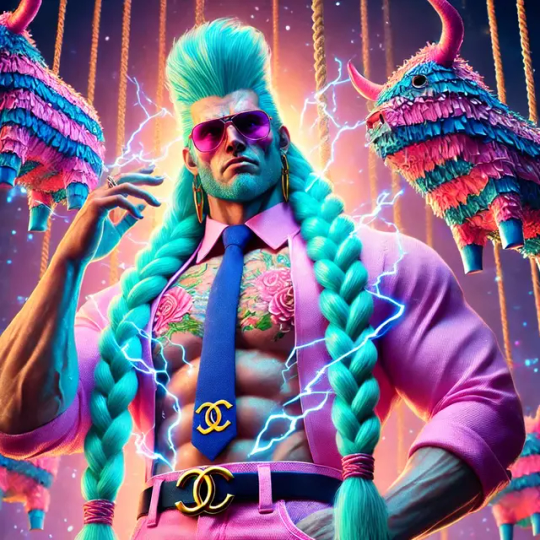

Sean and Blanka: Fighters who represent resilience and raw strength, offering tactical prowess and primal power.
T. Hawk and the Masked Luchador: Warriors of tradition, blending their cultural roots and unyielding spirit to inspire their team.
Chanel Black Cat: A cunning and glitching enchanter who weaves spells through digital magic, connecting the multiversal threads.
Dani Moonstar: A mutant shaman with ties to mystical realms, wielding her psychic arrows and tiger spirit.
Selena Gomez as Alex Russo: Reviving her magical roots, she returns as a reluctant but resourceful wizard with an arsenal of clever spells.






The Civilian Allies
Among the chaos, a team of extraordinary "ordinary" people lend their support:
Bad Bunny, Daddy Yankee, and Darling (Gooneychnga the Rap Boca): Musicians turned freedom fighters, using their lyrical talents and charm to rally resistance movements.
Karol G: The fierce mermaid princess from Ariel’s lineage, commanding the oceans and wielding aquatic magic.
Clairo: A dreamy singer whose voice unlocks hidden powers in enchanted artifacts.
Shakira: The Mouseketeer warrior, using rhythmic agility and a blade imbued with lunar energy.
Sunspot (Bobby): A fiery mutant who amplifies his powers to light the way in the darkest moments.
Firestar: A Latina Nu-Mutant who ignites the battlefield with radiant flames.
The Sega Cameos
Joining from the Sega dimension are Espio the Chameleon, whose stealth and ninja skills provide critical intelligence, and Vector the Crocodile, bringing raw muscle and investigative expertise.
The Moon Drop Girl
The key to resolving the Convergence is Moon Drop, a mysterious hybrid of Chao and human with ethereal beauty and immense power. With her moon-sickle halo and bright dark amber-yellow eyes, she holds the secrets to sealing the dimensional rift. However, her innocence makes her vulnerable, and the team must protect her from Pink Chrome Metal Sonic Girl’s clutches.

The Final Showdown
In the climactic battle, the heroes confront the antagonist on a celestial battlefield where reality bends and shifts. Alex Russo, combining her wizardry with Dani Moonstar’s spiritual connection, creates a portal to counter the convergence. Meanwhile, Elena, Blanka, and T. Hawk hold the front line against Pink Chrome Metal Sonic Girl’s army.
Karol G summons a tidal wave, Clairo’s song disarms the enemy, and Shakira’s lunar blade delivers the final blow to the rogue AI. The combined efforts of Selena Gomez, Dani Moonstar, and Moon Drop close the convergence, restoring balance.
Aftermath
The dimensions are saved, but bonds are forged across worlds. Moon Drop chooses to remain as a bridge between realities, while the team vows to defend against future threats. Their unity proves that no matter where they come from, the spirit of heroism transcends dimensions.
Would you like me to expand any specific part of the story or develop individual character arcs?
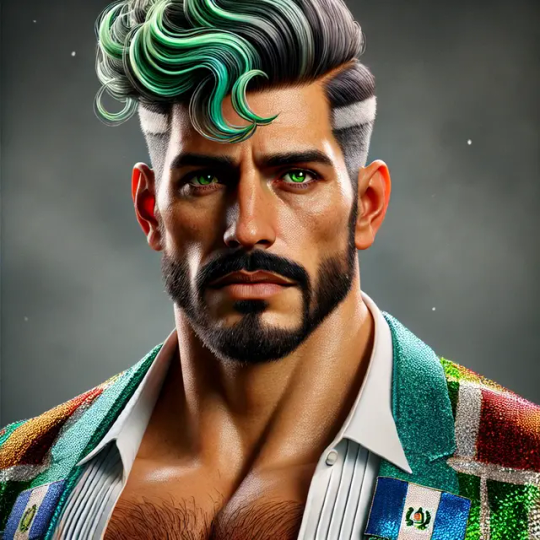
Here is a list of notable Latino Marvel heroes and their contributions to the Marvel Universe:
Latino Marvel Heroes
America Chavez (Miss America)
Real Name: America Chavez
Powers: Super strength, flight, interdimensional travel by creating star-shaped portals.
Heritage: Puerto Rican (from a utopian parallel dimension).
Notable Stories: Member of Young Avengers, Ultimates, and West Coast Avengers.
Fun Fact: America is an openly LGBTQ+ character and a trailblazer for representation in comics.
Robbie Reyes (Ghost Rider)
Real Name: Roberto "Robbie" Reyes
Powers: Possessed by the Spirit of Eli Morrow; transforms into Ghost Rider with superhuman strength, invulnerability, and a Hellfire-powered car.
Heritage: Mexican-American.
Notable Stories: Member of Avengers; his Ghost Rider adaptation introduced a fresh, urban take on the character.
Sunspot
Real Name: Roberto da Costa
Powers: Absorbs solar energy to gain super strength, flight, and energy projection.
Heritage: Brazilian.
Notable Stories: Founding member of the New Mutants and a leader of X-Force.
White Tiger
Real Name: Hector Ayala (Original White Tiger); Angela del Toro; Ava Ayala
Powers: Super strength, agility, and enhanced senses from the mystical Tiger Amulet.
Heritage: Puerto Rican.
Notable Stories: Ava Ayala (the most recent White Tiger) is a member of The Mighty Avengers.
Miles Morales (Spider-Man)
Real Name: Miles Morales
Powers: Spider-like abilities similar to Peter Parker, plus invisibility and bio-electric venom blasts.
Heritage: African-American and Puerto Rican.
Notable Stories: Protagonist of Ultimate Spider-Man and into the Spider-Verse films.
Anya Corazon (Spider-Girl/Arana)
Real Name: Anya Sofia Corazon
Powers: Wall-crawling, enhanced strength, and agility; later gains spider-like carapace armor.
Heritage: Mexican and Puerto Rican.
Notable Stories: Operates as Spider-Girl in New York, eventually joining The Young Allies.
Firebird
Real Name: Bonita Juarez
Powers: Fire manipulation, flight, and immunity to toxins and radiation.
Heritage: Mexican.
Notable Stories: Member of The Rangers and ally of the Avengers.
Nova (Sam Alexander)
Real Name: Samuel Alexander
Powers: Super strength, flight, and energy manipulation as part of the Nova Corps.
Heritage: Mexican-American.
Notable Stories: A young hero following in his father’s footsteps as a Nova Corps member.
Living Lightning
Real Name: Miguel Santos
Powers: Turns into living lightning, allowing energy manipulation, super speed, and flight.
Heritage: Mexican-American.
Notable Stories: Former member of the Avengers and The Rangers.
Reptil
Real Name: Humberto Lopez
Powers: Can transform parts of his body into dinosaur-like forms.
Heritage: Mexican-American.
Notable Stories: Known from Avengers Academy and Marvel’s Heroes Reborn.
Cecilia Reyes
Real Name: Cecilia Reyes
Powers: Generates a protective bio-field around her body.
Heritage: Puerto Rican.
Notable Stories: A reluctant hero and medical doctor for the X-Men.
Victor Mancha
Real Name: Victor Mancha
Powers: Technologically enhanced; controls metal and electricity.
Heritage: Latino (mother was Mexican).
Notable Stories: Member of the Runaways.
Echo (Maya Lopez)
Real Name: Maya Lopez
Powers: Mimics any physical action she observes, making her a formidable fighter.
Heritage: Native American (Cheyenne) and Latina.
Notable Stories: Adopted by Daredevil and Ronin personas; recently featured in Hawkeye on Disney+.
Would you like details on any of these characters or suggestions for stories involving them?
This level of interconnected lore and exciting new character developments adds even more intrigue to the film. Let’s delve into how these elements can be integrated into the Talisman storyline, as well as the broader Marvel-Disney cinematic universe:
America Chavez’s Cameo
Role in the Film: America Chavez (played by Xochitl Gomez) appears in a critical scene where Dani Moonstar and Magik are trapped in a collapsing dimension. Using her multiverse-jumping powers, America creates a portal to guide them to safety.
Connection to the Plot:
America senses the dimensional disturbances caused by the vengeful spirits and arrives to investigate.
Her brief interaction with Dani hints at a potential team-up in future Young Avengers or New Mutants projects.
Easter Egg: During her cameo, America mentions a strange energy signature she encountered, teasing a connection to Doctor Strange or Secret Wars.
Dora’s Marvel Transition
Introduction of Dora: The mysterious character "Dora" is revealed to be a Marvel reimagining of a beloved animated character transitioning into the superhero genre. Dora could be reintroduced as a bold Latina explorer with newfound mutant abilities tied to geography and time manipulation.
Role in Talisman:
Dora joins Dani and Magik, using her powers to navigate the ghost town and unearth its hidden secrets.
Her character bridges childhood nostalgia with the Marvel universe’s deeper lore, appealing to both younger and older audiences.
Sophia the First and the Kingdom Hearts Connection
Sophia as a Teenager:
The grown-up version of Sophia (played by a young actress like Jenna Ortega) makes a brief appearance as a magical ally who provides crucial information to Dani and Magik.
Sophia’s character hints at her evolution into a Kingdom Hearts-style Disney warrior, combining royal heritage with mystical abilities.
Kingdom Hearts Movie Teaser:
Sophia drops the name “Kiraara” or “Lila,” a new Disney-Japanese manga-inspired princess.
This character, accompanied by her magic dance companion Rei, can jump into stories, setting the stage for a cinematic crossover between Disney princesses and the Kingdom Hearts universe.
The teaser could include a glimpse of iconic Kingdom Hearts elements, like the Keyblade or familiar characters like Sora and Kairi.
Kiraara or Lila: The Manga-Inspired Disney Princess
Design and Abilities:
Kiraara/Lila is a magical dancer with powers tied to storytelling, allowing her to physically enter and reshape tales through her movements.
Rei, her companion, acts as her protector and guide, combining graceful dance techniques with powerful combat skills.
Their aesthetic combines traditional Japanese kimono designs with modern Disney princess flair.
Role in Future Projects:
Her introduction teases a larger Disney cinematic universe involving Japanese manga-inspired storytelling and crossovers with Marvel and Kingdom Hearts.
Impact on the Marvel-Disney Universe
The inclusion of America Chavez, Dora, Sophia, and Kiraara/Lila broadens the appeal of Talisman and sets up exciting possibilities:
America Chavez: Strengthens connections to Marvel’s multiverse storylines.
Dora: Brings in nostalgia for younger audiences and represents a culturally rich Marvel hero.
Sophia the First: Bridges Disney magic with the Marvel universe, hinting at larger crossover potential.
Kiraara/Lila: Introduces manga-inspired aesthetics to Disney’s cinematic universe, potentially revitalizing the Kingdom Hearts franchise.
Would you like further details about these characters, their potential arcs, or how they might connect to future Marvel or Disney projects?

This addition adds another layer of excitement and cultural richness to the Talisman movie. Let’s flesh out how Nelly Furtado’s song, her cameo, and the inclusion of Amara’s character elevate the movie:
Nelly Furtado’s Debut Song and Cameo
Nelly Furtado contributes a powerful and ethereal track for the movie’s soundtrack, titled “Luz y Sombra” (Light and Shadow). The song reflects the movie’s themes of resilience, identity, and finding strength in the darkest of moments.
Song Description:
A haunting blend of acoustic guitar, indigenous rhythms, and orchestral elements, transitioning into an empowering anthem.
Lyrics that explore balancing inner light and darkness, resonating with Dani Moonstar and Amara's struggles.
Cameo Appearance:
Nelly plays herself, performing at a mystical event hosted by the local community to honor their ancestors.
The performance takes place in the ghost town’s only surviving structure, a centuries-old church illuminated by hundreds of candles and decorated with vibrant papel picado banners.
Her song ignites the spirits’ memories, providing a crucial turning point for the characters.
Amara’s Role in the Movie
The fan-favorite mutant Amara Aquilla, also known as Magma, makes a triumphant return to the Marvel universe. Played by a surprise guest (rumored to be a prominent Disney Channel star or a beloved telenovela actress from Disney Latin America), Amara plays a pivotal role:
Backstory: Amara, who has been living in exile due to the uncontrollable nature of her volcanic powers, becomes a guide for Dani and Magik as they navigate the haunted burial grounds.
Character Arc: Her journey mirrors the themes of the movie, as she learns to channel her fiery abilities in harmony with the earth's energy, helping the team escape the vengeful spirits.
Rumored Cast Expansion
Michelle Rodriguez’s Feature Debut: Michelle Rodriguez is rumored to play a new mutant character tied to the Eldritch spirits—possibly a descendant of their original guardian. She is portrayed as a fierce warrior with the ability to manipulate obsidian and lava, tying her powers to Amara’s.
Amara’s Actress: Speculation surrounds several potential candidates:
Isabela Merced: Known for her strong performances and ability to balance vulnerability and power.
Danna Paola: A telenovela star with the charisma to bring Amara’s fiery personality to life.
Impactful Moments in the Movie
The Event: The movie’s pivotal scene takes place at a vibrant Día de los Muertos celebration in the ghost town. Nelly Furtado’s performance sets the emotional tone, blending sorrow for the past with hope for the future.
Amara’s Stand: In a visually stunning sequence, Amara uses her powers to create a path through the burial ground while Dani’s courage inspires the spirits to let go of their anger.
Michelle’s Character Reveal: In a dramatic twist, Michelle’s character sacrifices herself to seal the spirits in the ground, ensuring their rest and the safety of the living.
Fan Service and Easter Eggs
Nelly’s performance features a cameo by Disney Channel Mexico’s Amara actress, hinting at her deeper connection to the X-Men universe.
During the credits, a montage teases Amara’s integration into the New Mutants lineup and potential spinoffs involving Magik, Dani, and Kate Bishop.
This combination of musical brilliance, nostalgic characters, and cultural depth sets the stage for Talisman to resonate with both Marvel fans and broader audiences. Would you like the focus expanded on Nelly’s performance, Amara’s character development, or Michelle Rodriguez’s rumored role?



"Ultra-luxury Prada x Christian Louboutin ballet slipper heel, 7-8 inches high, crafted from iridescent silk sharkskin textile by Chanel. Features 21-inch lace ribbons to tie elegantly around the thigh, blending sophistication with avant-garde fashion. Showcase intricate detailing, high-gloss finish, and a cinematic, high-fashion aesthetic."

Tiger lilly if Neverland, wearing. Beaded swim suit, micro bikini of rare clay from the depth of Tinkerbell's most darkest mines, the blackness of dark is so intense the light of the dEkness shines a a invisible light of black matter in a 1% percent refraction of the milky ways lumenesence of eclipse shadow light, a kind of light that absorbs the absence of color in a black encapsulated darkness defining the light in a substrate of alternate dimensioncreating a prism from a metallic dense object of rare extraterrestrial metal such as the tesseract cube or an element not known in this universe, or what grime created in a lab harnessing. Frequency and piezii in a Oregon created in a pressure vacume of a blackhole what she titles Force Lace gravity of hem 2% mass induction of π /.2⁰
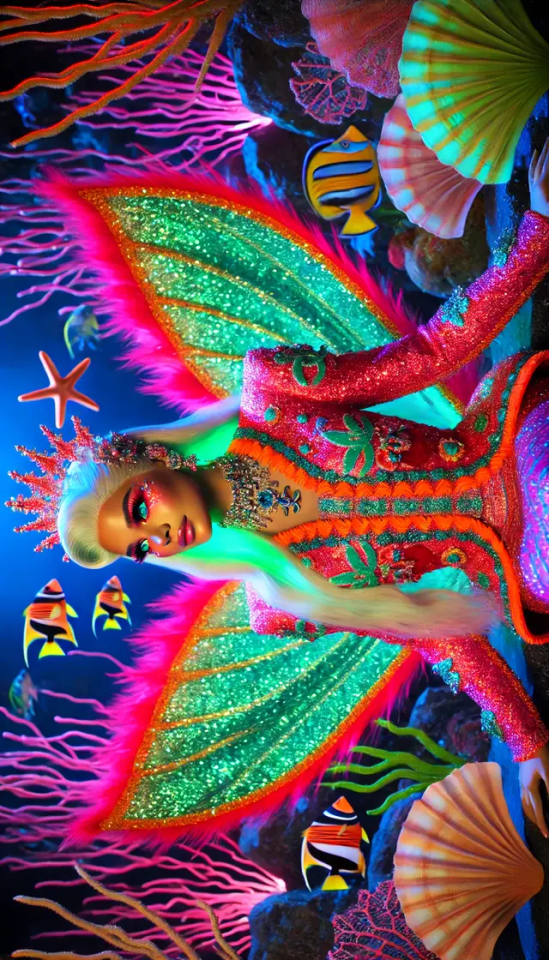
#KarolG #DisneyMermaidPrincessSister #SistersOfAriel #Atlantians#DajghtersOfTrident #KingdomHeartsTheeMovie
#ReymundoMarvel#BeckyG#Selena Gomez#Alex Russo#Pink chrome metal sonic#Espió chameleon#Vector crocodile#Sega#Capcom#THawk#Blanka#Street fighter#Vanessa Judge ds#Pocahontas#Shakira#Karol G#Entourage#Darling#Clario#Blue boy#Dolce de'spera#Boca#Fuego#Dale#Kpop#Shannon Williams#Latin marvel#Chicano marvel#Tarina Tarantino#Dora Tomb raider
3 notes
·
View notes
Text
Submission guidelines
Art Guidelines and Submissions Guidelines for submissions:
1. Be sure to have filled the sign-up form before you submit. 2. Subject matter is your choice, so long as it stays within the theme of the Paper Mario series, i.e. games with Paper Mario in the title. It can be a single character, a group, a location, an event, an abstraction, anything! Please keep it PG-13 or lower. Works that are outright pornographic, extremely violent, or otherwise offensive or controversial will not be allowed. AI-generated art will result in being banned from the project. 3. Size ratio can be your choice, so long as the art is vectorized in a .pdf or .psd format and can be upscaled/downscaled without losing quality. Maximum size is 10000x10000 pixels. The resolution should be 300 dpi or higher. 4. Writings should be submitted as pdf and be able to be copied and formatted. Word limit is 7k. 5. Animation/Videos must be H.264 compliant, such as .mp4 and .mov. The runtime limit is 5 minutes. 6. Audio must be submitted in .mp3 or .wav format. The runtime limit is 5 minutes. 7. 3D projects must be submitted in U3D 3rd Edition or PRC format, or created in a pdf first then sent to the director for accurate lighting. If the pdf doesn’t accept your project, screenshots are a valid option, with a maximum of 10 pictures in .pdf or .psd format. 8. Please submit files directly to [email protected], along with your chosen name/handle and up to 3 links to your blog/portfolio/webcomic/etc (up to 140 characters). These links will be displayed to the public, be sure you want to share them. Include a square icon that can be used to represent you. Maximum size of 1000x1000 pixels. Please do not use stolen art; if you cannot provide an icon, you may ask for assistance through the zine’s director or the zine’s Discord. 9. For multiple submissions, please include all in the same email if possible.
Please submit your works by May 11
All art belongs to you first and foremost and this zine claims no ownership of it. If you wish to post it, please wait until the zine is released and the director has given the go-ahead. Linking back to the zine would be much appreciated as well!
Thank you so much for all your hard work! :)
11 notes
·
View notes
Text
My Favourite Duel in Each Yugioh Series
I have done specific posts on some duels in the Yugioh franchise so a few of my picks might be obvious. Still, I figured I’d make this anyway. I won’t include Go Rush since it’s not complete and because my favourite duel so far is a rather spoilery one. DM - Sevens only!
Favourite DM Duel - Yugi vs Atem

Probably a generic pick but this really does stick out to me as a pretty solid duel, even as someone who’s not really a fan of DM’s super long, often lawless duels. I think it showcases the development and bond Yugi and Atem have over the course of the series really well. It was the perfect note to end the show on and seeing Yugi face off against all three Egyptian God cards was a blast.
Favourite GX Duel - Judai vs Yugi
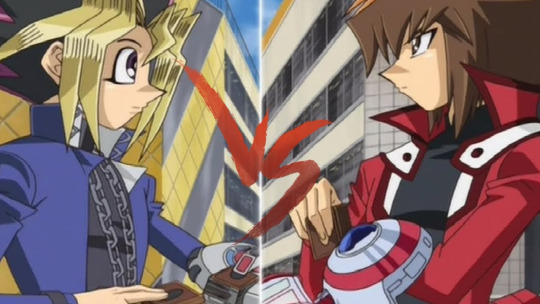
Okay I promise these won’t all be the final duels. GX honestly had a ton of great picks for me. Ryo vs Yubel, Judai vs Darkness, Judai vs Yubel, and Judai vs Ryo 2 all rank pretty highly for me but Judai vs Yugi is the one I have the most fun with. It does exactly what it sets out to do: Judai regains his love of duelling and duels on par with a duelling legend: his idol, the protagonist of the first series. It’s blatant fanservice but it fits the narrative and Judai’s character arc well so I never minded it. I think the constant back and forth of this duel is just really fun and it makes me smile every time I watch it.
Favourite 5Ds Duel - Jack vs Carly

Another close call honestly but as much as I adore the Team Taiyo duel and a lot of Akiza’s duels, I gotta give the edge to the one duel that truly hooked me on my first viewing on 5Ds. Jack vs Carly goes so damn hard. It’s heartbreaking in all the right ways and perfectly shows Jack and Carly’s growth over the arc. And… man, I always get teary eyed at the way the duel ends. I never expected Jack to try and die with Carly. It was such a shocking yet impactful moment that every time I see the card Shockwave now, I can’t help but immediately associate it with that powerful moment.
Favourite Zexal Duel - Nasch vs Vector

Maybe a bit of an unconventional choice and while I was tempted to go with Yuma and Kaito’s fun rematch, I went with this one for the fact that it just always stuck out the most to me. I just was not expecting Vector to lose so the sheer unpredictability of this duel for me, plus how entertaining Vector always is coupled with the really well done backstory portions covered in this duel make it stick out as my favourite Zexal duel.
Favourite Arc V Duel - Sora vs Shun

I know, I know, generic opinion but this really was such a huge turning point, and a betrayal I never saw coming. I love how it gets more intense and war-like as it goes on, with Sora’s monsters becoming more and more twisted as he himself shows off more of his true twisted colours. It’s some great stuff.
Favourite VRAINS Duel - Ai vs Playmaker

Even without the power of its ending, this duel really does a great job at showing the extent of both Playmaker and Ai’s power, with a lot of back and forths and both of their greatest monsters duking it out. And the way the duel slowly unravels the layers to Ai’s motivation and brings everything to light in time for that painful as all hell ending is magnificent. This is the best instance of the final “protagonist versus their spirit guide who’s been by their side the entire series” duel for me. It was the most heartbreaking and the most interesting.
Favourite Sevens Duel - Yuga vs Roa 1

Sevens has a lot of fun duels. I could’ve gone with just about any duel from the tournament finals but I’ve decided on the early Yuga vs Roa because of how much the content of that duel sticks out to me. This duel managed to concoct a scenario where the protagonist drawing his ace, something any other duel would consider the start of a comeback victory, will lead to him automatically losing the duel through disqualification, as it’s learned halfway through the duel that Yuga’s ace is potentially an illegal card. So Roa spends a portion of the duel forcing Yuga to draw more and more cards to try and force that disqualification as the rest. And honestly those scenes of Roa forcing Yuga to draw cards are some of the most intense Sevens gets. It’s such a neat subversion of the usual Yugioh trope, which is what I believe Sevens, particularly its first half, was best at so I had to give this duel a shout out.
#yugioh#ygo#yugioh duel monsters#ygo dm#duel monsters#yugioh gx#ygo gx#gx#yugioh 5ds#ygo 5ds#5ds#yugioh zexal#ygo zexal#zexal#yugioh arc v#ygo arc v#arc v#yugioh vrains#ygo vrains#vrains#yugioh sevens#ygo sevens#sevens
14 notes
·
View notes